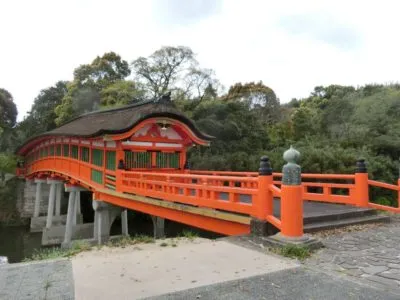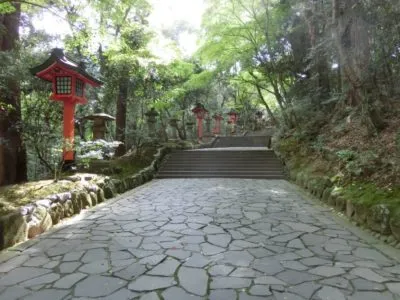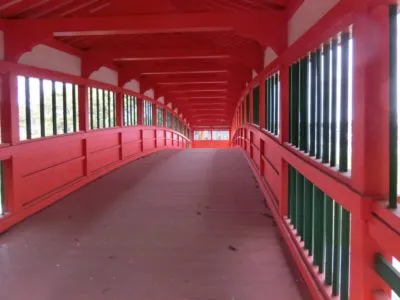Usa Jingu, also called Usa Hachiman Shrine, is located at the entrance of the Kunisaki Peninsula in Oita Prefecture. It was founded in the 8th century and it is one of the oldest Shinto shrines in Japan.

Hachiman Shrine
In Japan, there are about 80,000 Shinto shrines and 44,000 of them are Hachiman shrines. A Hachiman shrine enshrines the 15th emperor Ojin who has been regarded as the god of warriors, so it was a very important shrine during the feudal time when Samurai governed the country. For example, Tsurugaoka Hachimangu is a big Shinto shrine in Kamakura near Tokyo. It was founded by Minamoto Family. Several generations later, Minamoto-no Yoritomo became the first shogun in Japan.
History of Usa Jingu
Usa Jingu is the headquarter of all the 44,000 Hachiman shrines in Japan. The shrine was founded in Kyushu in 725, during the Nara period. History says that the spirit of Emperor Ojin appeared here in the 6th century and people built a shrine at the site.
A temple called Miroku-ji was built next to it in 779, making it what is believed to be the first shrine-temple, jingu-ji in Japanese. The resulting mixed complex, called Usa Hachimangu-ji, lasted over a millennium until 1868. This was when the Buddhist part was removed to comply with the Kami (Shinto gods). They did this because of the Shinto-Buddhism Separation Act that was just established by the new government.
The Usa Hachiman shrine first appears in the chronicles of Imperial history during the reign of Empress Shotoku. The empress allegedly had an affair with a Buddhist monk named Dokyo. An oracle said that the monk should be an emperor, and the kami Hachiman at Usa was consulted for verification. The empress died before anything further could develop.
In the 16th century, the temple was repeatedly attacked by the Christian-sympathizing lord of Funai Otomo Yoshishige and destroyed many times. The wife of Yoshishige, Otomo-Nata Jezebel was the High Priestess alongside the Nara Clan and resisted her former husband’s attacks. The Usa Jingu was designated as the chief Shinto shrine for the former Buzen province.
From 1871 through 1946, Usa was officially designated one of the Kanpei-taisha, meaning that it stood in the first rank of government-supported shrines. Other similarly honored Hachiman shrines were Iwashimizu Hachimangu of Yawata in Kyoto Prefecture and Hakozaki-gu of Fukuoka in Fukuoka Prefecture. These are collectively called the Three Hachimangu Shrines in Japan.
Precinct of Usa Jingu
The precinct of the shrine is huge. First, you cross the bridge Shinkyo, then you are in the sacred grounds. Then you will pass the big vermilion colored torii gate and walk straight forward, after which you have to go up the long steps because the main hall is constructed on the top of the hill. You may have a sense of holiness walking through the approach surrounded by the old trees.

If you are not in a condition to walk up the long steps, there is a cable car to the top of the hill. It is free of charge.
They enshrine three ‘kami’ in the main hall. The first one is Hachiman or Emperor Ojin, the second one is Himeno-Okami, an important goddess in the Kyushu region, and the third one is Empress Jingu who was the mother of Emperor Ojin.
The main hall and the Kujaku Monkei are designated as Japan’s National Treasures. The structures which comprise the current shrine complex were built in the middle of the 19th century. The characteristic construction, called Hachiman-zukuri, consists of two parallel structures with gabled roofs that are interconnected with the non-gabled side to form what internally is a single building. But if you see it from the outside, the complex still gives the impression of being two separate buildings.

On the way back, please don’t forget to see Kurehashi Bridge, it is a beautiful bridge covered with a vermilion colored roof. You cannot actually cross the bridge and you have to walk on another Shinkyo bridge, but you can see the inside of the Kurehashi Bridge.
Your Japan Tour
As seasoned Japan experts, we create perfect Japan package tours including destinations like Kyushu. Check out our group tours and private tours, or contact us to start planning your unforgettable holiday to this fascinating country full of once-in-a-lifetime experiences, culture, history, nature, and delicious food!
Access Information
Access: 10 minutes ride on the bus from Usa Station to the Usa-Hachiman bus stop.
Entrance: Free
Hours: From April to September 5.30 am – 7 pm / From October to March 6 am – 7 pm